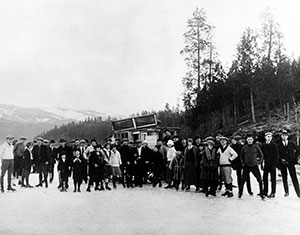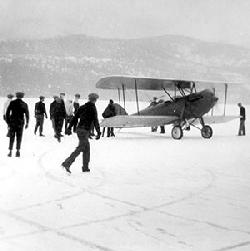|
||||
|
History: Ice skating provided winter draw to Liberty Lake
12/31/2013 10:58:38 AM

Photo courtesy of Liberty Lake Historical Society
A group of ice skaters gather at Liberty Lake.
By Karen Johnson
Liberty Lake Historical Society
One of the greatest romances of winter is the graceful gliding of skaters along a frozen pond filled with laughter and joy in refreshingly crisp air. Inland Empire skating captured in the writing of the early 1900s centered on flooded backyards, the quaint frozen neighborhood ponds of Manito, Cannon Hill and Wandermere, and the unlikely but wildly alluring wind on your faces in the open spaces of far-away Liberty Lake.
In December 1901, chatter around the young, elite Spokane Athletic Club included an endorsement of wintertime lake excursions. "Several wagonloads" of ice skaters could be transported to Liberty Lake, where the ice was "fine" and "nearby farm houses offered shelter and good food." Thus began weekend skating parties to the prized lake. It was reported that hundreds of skaters would visit on a given day.
Somewhere around a decade later and emboldened by the popular ice excursions, train entrepreneurs who'd been transporting beach-bound Spokanites to the shores of Liberty Lake Park expanded to include ice-bound skaters during the winter months. By 1916, skating parties could board the Spokane & Inland Empire Rail Road on as many as three lake-bound trains and return to town on one of four. Organized parties could charter a train for $25 which would return to Spokane whenever its passengers agreed to leave. C.O. Jenks, general manager of the S&IE, ordered a portion of the lake to be cleared for skating as well as a 30- to 40-foot swath that ran across or sometimes even around the lake. He employed two teams of road scrapers to accomplish this massive task. It's unclear if these "teams" were the old, commonly used road scrapers pulled by teams of two horses or mules, or possibly two crawler tractors (introduced in the US in 1900) fitted with newly patented, machine-grade road scrapers.
|
Did you know?
• A Dec. 12, 1931, Spokane Daily Chronicle article showed just how important good, smooth ice was: "Inland empire skaters are certain to be happy for at least one more Sunday, barring earthquakes or other disasters that would ruin the ice."
• The Depression cost Petty-Skok both her Liberty Lake family cottage and 1932 Olympic dreams when she didn't have the financial backing to go. Although devastated, perseverance (and a patient fiancé) enabled her to compete in 1936. Two days before her event, she got food poisoning. She barely missed a bronze medal but refuses to use the food poisoning as an excuse. • Ice begins to be "safe" at around 4-6 inches thickness. Do not even walk on ice 3 inches or less. For more on ice safety, visit www.wikihow.com/Know-When-Ice-is-Safe • We are looking for your personal Liberty Lake stories (long or short, 1970s or earlier) and/or pictures for a collection to be published in our 2015 series in The Splash. We are available to help you write your stories if you desire. What's your Liberty Lake adventure? Submit yours and others' stories along with your name and contact information to LibertyLakeHistoricalSociety@gmail.com. Events, Competitions and Activities From the Liberty Lake Historical Society, a 2014 monthly series
January - Ice Skating
February - Parade of Mermaid Competitions
March - Opening Day of Fishing
April - Dancing
May - Water Competitions
June - Liberty Lake Amateur
July - All Valley Picnics
August - Dutch Jake Picnics
September - Hydroplane Races
October - Baseball Games
November - Liberty Lake and Football
December - A.R.T.'s Christmas in July
|
But lake adventures weren't exclusive to clubs or city folks pursuing a day's outing. Cabins and cottages began dotting the lakeshore early in the century. Though they weren't year-round residences, they provided all that was needed to enjoy longer stays at the lake regardless of the season.
When the delightfully young, 98-year-old Mary Lou Petty-Skok speaks, listeners effortlessly linger on her infectious memories of life at Liberty Lake. Mary Lou, as Splash readers likely recall, is a jewel in Liberty Lake's history. She catches our attention because she swam the 400-meter freestyle for the United States in the 1936 Olympics in Berlin (placing a respectable fourth), but she captures our hearts because she embraces all of life, good and bad, with a humble, positive and contagious attitude.
The year Mary Lou was born, 1915, the Petty's began to hang out in a small "cottage" someone had pulled up on the beach at MacKenzie Bay. The family frequented this place until 1918, when Mary Lou's father built three cottages south of Dreamwood Bay near the old "forbidden" Stonehouse. One cottage housed her immediate family, and the other two belonged to relatives. Their three families, which included six kids, also shared a deluxe, three-room outhouse fondly dubbed "Hustle Inn."
From late grade school through early high school, Petty joined other neighborhood kids in meeting at the closest ice house to load their wagons with ice chunks sawn from the frozen lake, perhaps three feet by three feet and whatever thickness was maneuverable, she recollects, and then pulled the loaded wagon home for refrigeration purposes. Even work was fun! Another favorite pastime on windy days was to skate against the wind for some distance, then turn, open their coats and ice sail back. Some things never change, though there have been many variations of "sails" spotted on Liberty Lake through the years!
"The weather was different in those days," Skok reminisced. "It would freeze, but (usually) no snow would fall until the week before Christmas, so the ice was amazing ... clean and clear; you could see the bottom of the lake!" During her high school years in the early 1930s, there were usually 10-15 kids who loved to play crack the whip - and this was no normal game of crack the whip!
"Everyone knew what to do!" Mary Lou quipped.
After outfitting a car (commonly driven on the frozen lake back then) with a 30-40 foot rope, skaters grabbed ahold and "skated like mad" to keep slack in the rope as the car managed to gain traction on the slick ice. The driver, heading for the tulies, blinked the lights when it got close and braked! The car would almost stop completely, and the skaters would "crack the whip"! One time Mary Lou fell and skidded spread eagle "almost as fast as the skaters!" Even after she was married, Mary Lou and her husband Bob Skok continued the tradition.
Perhaps it's been the excitement of the adventure that's lured people here throughout the years - train rides, parties with friends, the beautiful setting, traditions, or the array of truly classy, entertaining events and venues. But the epitome of the adventure - whether it's skating, fishing, water skiing, swimming, golfing, bicycling or another of LL's great amenities - lies in the attitude. Thanks, Mary Lou, for the example.
Karen Johnson is a longtime resident and Liberty Lake Historical Society board member.



